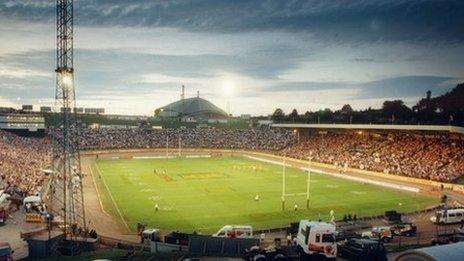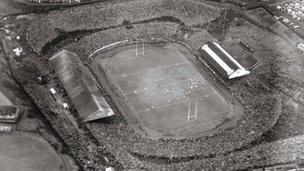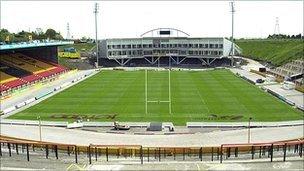Bradford Bulls' Odsal Stadium 'takes breath away'
- Published

The ground's setting creates a "sense of theatre" according to John Downes
Not that you'd know it from outside the turnstiles on Rooley Avenue but the plain breeze block wall conceals a huge arena that has often been described as the 'Wembley of the north'.
Odsal Stadium, the home of Bradford Bulls, has just been bought by the sport's governing body for an undisclosed sum to avoid "predatory approaches", according to Rugby Football League chairman Richard Lewis.
It has bought a ground where the pitch is housed at the bottom of a huge bowl and at the entrance level spectators can look down from the rim on to the roof of the stand.
Although Bradford Northern (now Bulls) was formed in 1907 the team played at several grounds before Odsal Stadium was opened in 1934.
Before that date the hollow was a vast council rubbish tip on the southern outskirts of Bradford.
'Sense of theatre'
The tip sat in a valley gouged out during the Ice Age about 10,000 years ago, geologists have concluded.
Its unusual setting makes for a "sense of theatre" according to John Downes, one of the club's heritage officers.
"The further down you get into the bowl the more crowd atmosphere you get - it's fantastic."
Mr Downes has been in crowds of more than 80,000 for games in the ground.
However, in 1954 the ground hosted the Challenge Cup Final replay between Halifax and Warrington, after a draw at Wembley. Nobody realised the game would attract a then world-record crowd for rugby league.
The official attendance that day was more than 102,000 but in truth the crowd may have been even larger.

Traffic jams built up as 102,000 packed the ground for the Challenge Cup Final replay in 1954
The long walk
Large traffic jams built up around the ground before kick-off and many spectators missed the start of the game and didn't always have a great view even after getting into the ground.
Originally the dressing rooms were built at the top on the stadium's rim and players had a long trek down hundreds of steps to the playing area.
At half-time during games most of the competing teams went into a huddle on the pitch rather than start back up the steps.
The walk to and from the dressing rooms could be an experience for referees and visiting teams, and especially for members of the opposition who had to make the long walk for an "early bath" after getting sent off.
Stuart Duffy, football and media manager of Bradford Bulls, remembered a referee being given a police escort, including mounted officers, for the long trek after a particularly contentious match.
When, in 1996, rugby league decided to change to a summer season Mr Duffy suggested the "vibrancy, colour and game-day entertainment" put on at Odsal went a long way to establishing the new competition.
Other sports featured at the arena have included football, speedway, show jumping and kabaddi.
'Micro-climate'
But it is primarily a rugby league venue and the biggest crowd inside the bowl during the modern era of rugby league is more than 24,000 for a game against local rivals Leeds Rhinos.
Mr Duffy summed up the effect on anyone seeing Odsal for the first time. "It takes your breath away", he said.
Despite being in a bowl the stadium is situated on a high piece of ground and during winter in particular was renowned for its changeable weather.

Many changes have been made to the ground over its history
Mr Downes, who was first taken to the ground in 1949 as an infant in his pram, said: "Odsal has its own micro-climate, it can be sunny in Bradford city centre and fog-bound here or vice versa.
"I remember one game against Wigan when the fog came round the back of the stand like a smoke machine and filled up the bowl.
"That was that, the match had to be abandoned."
Many changes have been made to the ground, concrete terracing replaced railway sleepers on the vast slopes of the bowl and stands have been knocked down and rebuilt.
However, the often suggested idea of upgrading the ground to make it the "Wembley of the north" has never been realised.
Despite the false starts and chequered history of the ex-council rubbish tip Mr Downes would have it no other way.
"I've spent the best times of my life in Odsal, it's been an honour to be involved," he said.